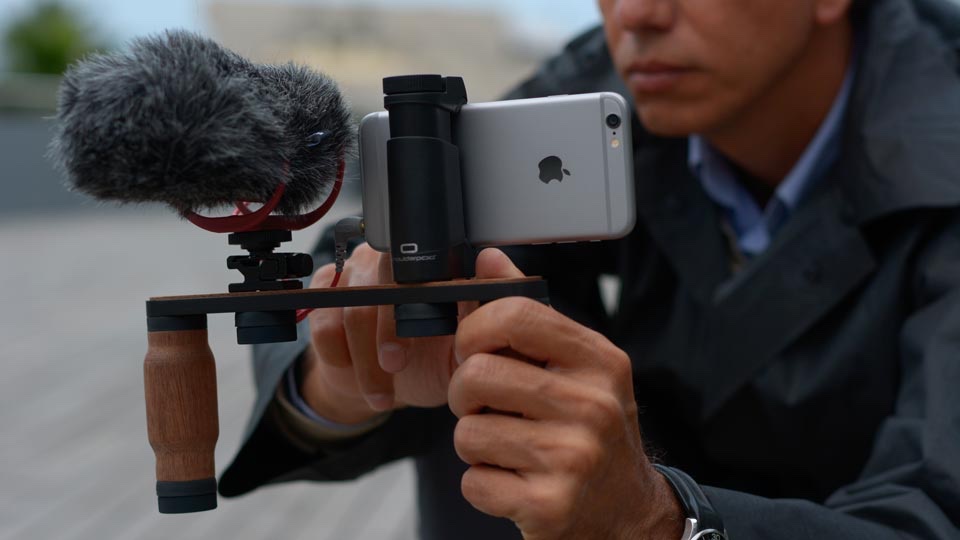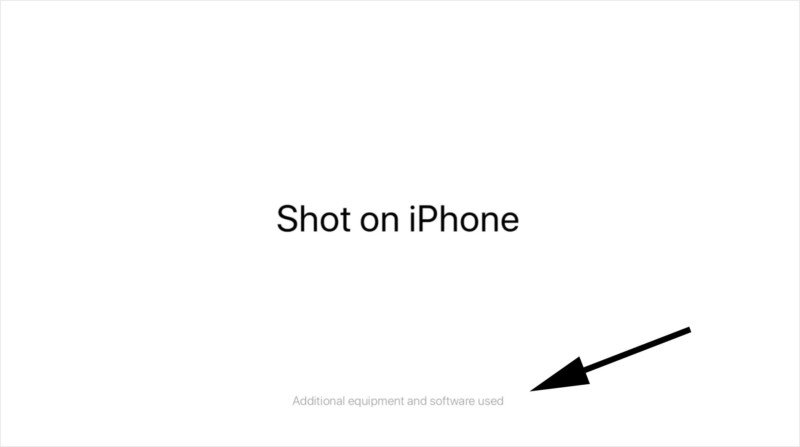The iPhone is one of the most popular and affordable cameras of all time. What does this actually mean for filming with him and how seriously can it be done?
iPhone status for movie
At present, the iPhone is still considered primarily the most affordable device that is always at hand and useful only for space layout, choreography or capturing snapshots. Even in these respects, however, it is very limited, especially due to the lens and shooting formats.
Example when Damien Chazelle He used the iPhone in the design the opening scene of the Oscar-winning La La Land, is rather unique and exactly fulfills the mentioned characteristics. The director did not specifically choose a smartphone, he just had it on hand as a basic means of simplifying scene blocking.
[su_youtube url=”https://youtu.be/lyYhM0XIIwU” width=”640″]
Of course, there were also many cases where the iPhone was used as a serious tool, such as Bentley ad or recent Detour, a short film by Michel Gondry, director Eternal light of the immaculate mind. In such cases, however, these are rather films that were created as iPhone promotions or, on the contrary, used the iPhone as a means of gaining attention.
The iPhone is only central, far from being the only piece of hardware
Capturing the pre-camera space itself requires a quality sensor and optics, although the iPhone should be seen as sufficient in this respect, it is only basic hardware and most filmmaking practices require the ability to focus differently, camera moves, resize and depth-compose the captured space from the same distance etc.
[su_youtube url=”https://youtu.be/KrN1ytnQ-Tg” width=”640″]
It is fundamentally impossible for a single camera to offer a sufficient number of these options without additional hardware. That's why iPhone-filmed movies and commercials almost always include the phrase "filmed with an iPhone using additional technology and software." The most important additional technique and software for shooting with an iPhone will expand the possibilities of its optics, settings of image parameters and shooting format, and in addition to a deliberately shaky image, it will also enable smooth camera movements.
They are mostly mentioned as the most useful apps for filming Filmic Pro a MAVIS. They mainly allow manual settings and a detailed overview of focus, color rendering, resolution and number of frames per second (the standard for film is 24 or 25 frames per second, 30 for TV in the USA and 25 in Europe), exposure and shutter speed, and also adapt settings depending on the other technique used (lenses and microphones). The latest versions of the applications also expand the captured dynamic range and color spectrum, which improves the possibilities of working with video in post-production, in professional programs such as DaVinci Resolve, Adobe Premiere Pro and Final Cut Pro X.
The most frequently purchased additional lenses for the iPhone are anamorphic lenses from Moondog Labs, which expand the captured image and can capture specifically cinematic, wide horizontal "lens flares" (reflections of light on the lens). Moment lenses and the more expensive Exolens from the famous Zeiss company are mentioned almost as often.
There are probably the most available camera stabilization tools and you can make them at home or spend tens of thousands for them, but the two basic choices from the camp of more accessible and expensive devices tend to be Steadicam Smoothee and DJI Osmo Mobile. For example, the Beastgrip Pro stabilizes shooting with an iPhone by adding weight and improving ergonomics, and also allows the attachment of additional hardware such as lenses, lights and microphones.
Finally, a very important part of the movies is also the sound, which is not quite suitable to be captured directly by the microphone built into the iPhone. Rather, it is appropriate to invest in renting semi-professional or professional microphones or in your own digital recorder, for example from Zoom or Tascam.
[su_youtube url=”https://youtu.be/OkPter7MC1I” width=”640″]
Aesthetics and philosophy of shooting with an iPhone
No matter how sophisticated the technique is, of course, it is useless in the hands of incompetent and uninspired creators. But the same can be true the other way around – more serious shooting with an iPhone requires investment in basic additional equipment, but for an interesting result it is not necessary to spend thousands, neither for the camera itself nor for other equipment.
Take a feature film as an example Tangerines shot on an iPhone 5S, which was met with great acclaim at Sundance, the world's largest independent film festival, a few years ago - not for what exactly it was shot for, but for the way it used the available resources.
Interesting films shot on mobile phones have been created since 2006 and technology has undergone huge changes since then, so the iPhone is more than sufficient for this purpose and the focus should be on its capabilities and different aesthetics rather than its limitations.
One of the most prestigious film magazines, Hollywood Reporter, in review Tangerines wrote that the iPhone, combined with the film's anamorphic lenses, lends a crisp, strikingly cinematic look, and is oddly aesthetically pure in a flood of over-polished indie films.
Another great example is a short film by the most famous South Korean director Chan-wook Park, Night Fishing, which, by creatively playing with the image limits of the iPhone 4 and frequently not using stabilization, creates an interesting combination of realism and stylization. The director appreciated the smartphone's ease of use and small dimensions.

dogma 95
In the current context of developing smartphone filming, it is interesting to reflect on the Dogma 95 filmmaking movement that developed in the second half of the nineties in Denmark and later spread throughout the world. It started with the writing of a ten-point manifesto regarding the theme, production and filming technique.
Of course, the iPhone does not meet the specific rules, but the goals that the filmmakers set by creating the manifesto are more important. Their intention was to simplify the process of creation and production as much as possible and to allow them to focus on the shooting itself. Individual actors often temporarily became cameramen themselves, the scenes were either largely or completely improvised, the actors often had no idea that someone was filming them, no additional lighting or backdrops were used, etc.
This made it possible to create a very specific realistic aesthetic, using the limits of budget and technique to its advantage. The films of this movement are raw and give the impression that anyone could make them, of course, assuming great talent. Their point is not to try to achieve the greatest possible control over the properties of the image and the resulting form of the film, on the contrary, they go against it and look for a new/different concept of realistic cinematography.
Since the iPhone is always at hand, it often has inconsistent focus and color rendering, and in poor lighting conditions there is a distinct digital noise, the films created by it can be even more freed from the prism of perceiving the film as something either contrived authentic or deliberately inauthentic. There is no need to remember only artistically not very valuable films such as The Blair Witch Mystery a Paranormal Activity, but just for Dogma 95 movies like Family celebration a Break the waves.
It can also be very interesting to use the aesthetics of early digital films or even vaporwave, for which raw, imperfect, aggressively digital visuals are typical. The iPhone should not compete with Red Epic or Arri Alexa and expensive Hollywood productions, but be an instrument of its own authenticity, of people with ideas who do not want to approach and imitate the techniques and rules of others, but look for their own.
Rather than trying to legitimize the iPhone as a potentially serious filmmaking tool, sometimes even by fetishizing the technologies used and placing them in the center of attention, it is perhaps more promising at the moment rather than bringing the iPhone film closer to the iPhone film. If the resulting work is perceived through the prism of the technique created to shoot it, it reduces or even eliminates its artistic value. In connection with the film Tangerines it is mostly about the methods and technique with which it was filmed. But its authors deliberately mentioned the iPhone for the first time only at the very end of the credits, so that it would be perceived as a tool for making a film and not as anything else.
Of course, technology is a significant part of cinematography, but ultimately it must only be a means of artistic expression, not the center of attention. Campaigns like "Shot On iPhone" certainly make sense as a promotion for the device, but in terms of actually legitimizing it as a tool for independent filmmakers, they are rather counterproductive as they tend to distract from the art itself.

I offer the mentioned iPro Lens for sale in the Jablíčkáře bazaar:
http://bazar.jablickar.cz/bazar/detail-inzeratu/?id=4467
The European TV standard does not have 30 frames per second but 25 (50i)
True, supplemented